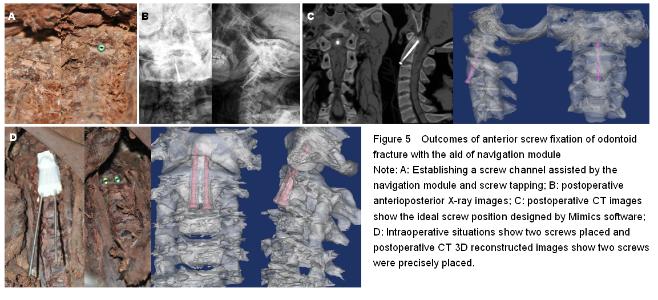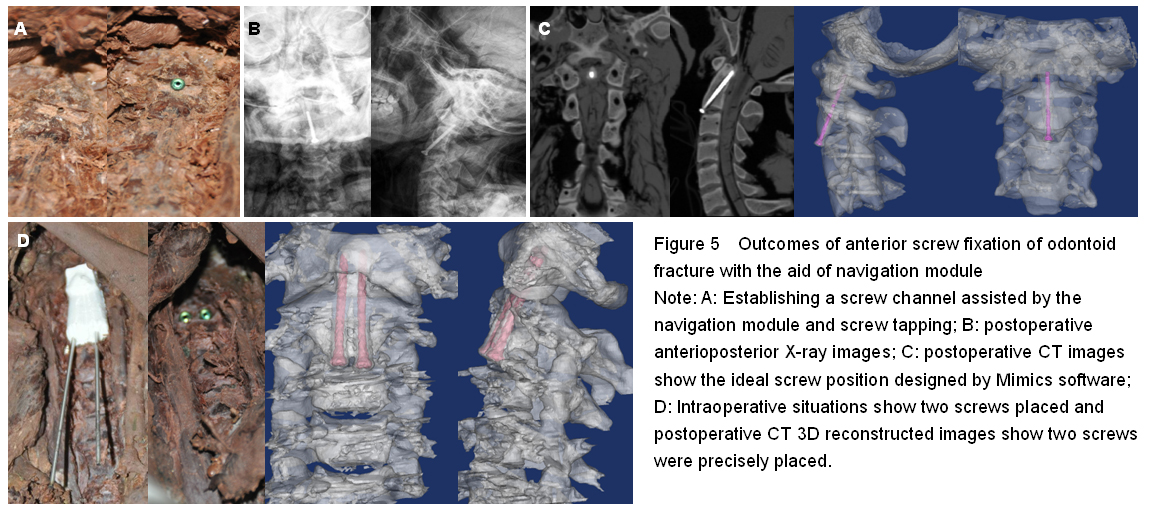| [1] Rajasekaran S, Kamath V, Avadhani A. Odontoid anterior screw fixation. Eur Spine J. 2010;19(2):339-340.
[2] Fountas KN, Kapsalaki EZ, Karampelas I, et al. Results of long-term follow-up in patients undergoing anterior screw fixation for type II and rostral type III odontoid fractures. Spine (Phila Pa 1976). 2005;30(6):661-669.
[3] Pryputniewicz DM, Hadley MN. Axis fractures. Neurosurgery. 2010;66(3 Suppl):68-82.
[4] Böhler J. Screw-osteosynthesis of fractures of the dens axis (author's transl). Unfallheilkunde. 1981;84(6):221-223.
[5] Koller H, Acosta F, Forstner R, et al. C2-fractures: part II. A morphometrical analysis of computerized atlantoaxial motion, anatomical alignment and related clinical outcomes. Eur Spine J. 2009;18(8):1135-1153.
[6] Osti M, Philipp H, Meusburger B, et al. Analysis of failure following anterior screw fixation of Type II odontoid fractures in geriatric patients. Eur Spine J. 2011;20(11):1915-1920.
[7] Brown GA, Firoozbakhsh K, DeCoster TA, et al. Rapid prototyping: the future of trauma surgery? J Bone Joint Surg Am. 2003;85-A Suppl 4:49-55.
[8] Paiva WS, Amorim R, Bezerra DA, et al. Aplication of the stereolithography technique in complex spine surgery. Arq Neuropsiquiatr. 2007;65(2B):443-445.
[9] Xie A, Fang C, Huang Y, et al. Application of three-dimensional reconstruction and visible simulation technique in reoperation of hepatolithiasis. J Gastroenterol Hepatol. 2013;28(2):248-254.
[10] White AP, Hashimoto R, Norvell DC, et al. M orbidity and mortality related to odontoid fracture surgery in the elderly population. Spine (Phila Pa 1976). 2010;35(9 Suppl): S146-S157.
[11] Dantas FL, Prandini MN, Caires AC, et al. Management of odontoid fractures using anterior screw fixation: analysis of 15 cases. Arq Neuropsiquiatr. 2002;60(3B):823-829.
[12] Ochoa G. Surgical management of odontoid fractures. Injury. 2005;36 Suppl 2:B54-864.
[13] Song KJ, Lee KB, Kim KN. Treatment of odontoid fractures with single anterior screw fixation. J Clin Neurosci. 2007; 14(9):824-830.
[14] Agrillo A, Russo N, Marotta N, et al. Treatment of remote type ii axis fractures in the elderly: feasibility of anterior odontoid screw fixation. Neurosurgery. 2008;63(6):1145-1150.
[15] Omeis I, Duggal N, Rubano J, et al. Surgical treatment of C2 fractures in the elderly: a multicenter retrospective analysis. J Spinal Disord Tech. 2009;22(2):91-95.
[16] Chiba K, Fujimura Y, Toyama Y, et al. Treatment protocol for fractures of the odontoid process. J Spinal Disord. 1996;9(4): 267-276.
[17] Wang MY. Cervical crossing laminar screws: early clinical results and complications. Neurosurgery. 2007;61(5 Suppl 2):311-325.
[18] Lantada AD, Morgado PL. Rapid prototyping for biomedical engineering: current capabilities and challenges. Annu Rev Biomed Eng. 2012;14:73-96.
[19] Magarelli N, Milano G, Baudi P, et al. Comparison between 2D and 3D computed tomography evaluation of glenoid bone defect in unilateral anterior gleno-humeral instability. Radiol Med. 2012;117(1):102-111.
[20] Wu ZX, Huang LY, Sang HX, et al. Accuracy and safety assessment of pedicle screw placement using the rapid prototyping technique in severe congenital scoliosis. J Spinal Disord Tech. 2011;24(7):444-450.
[21] Uehara M, Takahashi J, Hirabayashi H, et al. Computer-assisted C1-C2 Transarticular Screw Fixation "Magerl Technique" for Atlantoaxial Instability. Asian Spine J. 2012;6(3):168-177.
[22] Hu Y, Yuan ZS, Spiker WR, et al. Deviation analysis of C2 translaminar screw placement assisted by a novel rapid prototyping drill template: a cadaveric study. Eur Spine J. 2013;22(12):2770-2776. |

